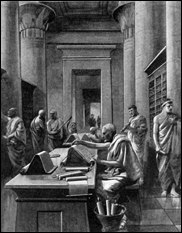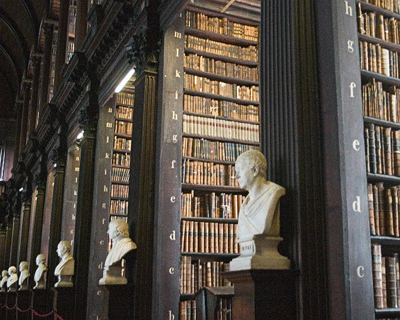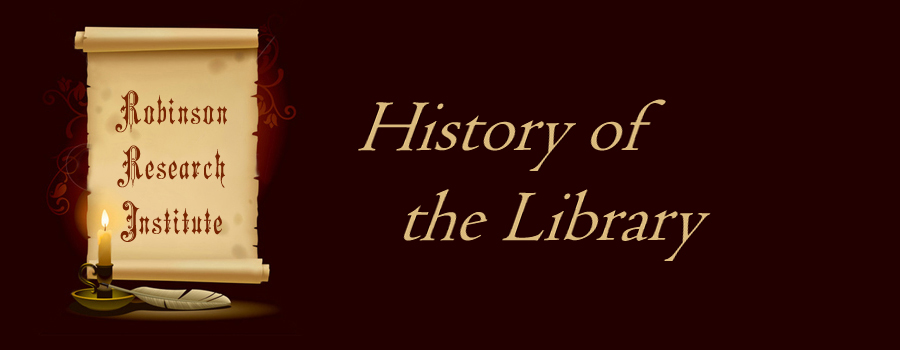|
History Magazine
Survivor: The History of the Library
THE COLLECTION OF written knowledge in some sort of repository is a practice as old as civilization itself. About 30,000 clay tablets found in ancient Mesopotamia date back more than 5,000 years. Archaelogists have uncovered papyrus scrolls from 1300-1200bc in the ancient Egyptian cities of Amarna and Thebes and thousands of clay tablets in the palace of King Sennacherib, Assyrian ruler from 704-681bc, at Nineveh, his capital city. More evidence turned up with the discovery of the personal collection of Sennacherib's grandson, King Ashurbanipal.
The name for the repository eventually became the library. Whether private or public, the library has been founded, built, destroyed and rebuilt. The library, often championed, has been a survivor throughout its long history and serves as a testament to the thirst for knowledge.
Literacy Builds Libraries
Early collections may have surfaced from the Near East, but the ancient Greeks propelled the idea through their heightened interest in literacy and intellectual life. Public and private libraries flourished through a well-established process: authors wrote on a variety of subjects, scriptoria or copy shops produced the books, and book dealers sold them. Copying books was an exacting business and one in high demand, because a book's "trustworthiness" translated into quality. An Athenian decree called for a repository of "trustworthy" copies. Though the public library first appeared by the fourth century bc, the private library was more prevalent. Aristotle, for instance, amassed a large private collection. Ancient geographer Strabo said Aristotle "was the first to have put together a collection of books and to have taught the kings in Egypt how to arrange a library."
Form Dictates Function
Throughout most of the library's history, the term "book" referred to works written on papyrus and some parchment rolls. Beginning in the second century, stacked and bound wooden boards recorded literature, science, and technical information. These tablets, called codex, derived from a centuries-old practice of using wooden writing tablets for notetaking. These new, durable codices gradually replaced the fragile rolls. However, rolls continued to be used for archival-type documents. Parchment eventually replaced the wooden boards.
The new codex form impacted book storage. Codices were stored flat on the shelf and covers protected their leaves. The libraries had to find ways to house both rolls and codices. New libraries emerging in the Middle Ages in churches, schools, and monasteries concerned themselves only with the codex form.
The Great Library

That library, of course, was the Great Library of Alexandria, a public library open to those with the proper scholarly and literary qualifications, founded about 300bc. When Egypt's King Ptolemy I (305-282bc) asked, "How many scrolls do we have?", Aristotle's disciple Demetrius of Phalerum was on hand to answer with the latest count. After all, it was Demetrius who suggested setting up a universal library to hold copies of all the books in the world. Ptolemy and his successors wanted to understand the people under their rule and house Latin, Buddhist, Persian, Hebrew, and Egyptian works - translated into Greek.
The library's lofty goal was to collect a half-million scrolls and the Ptolemies took serious steps to accomplish it. Ptolemy I, for example, composed a letter to all the sovereigns and governors he knew, imploring them "not to hesitate to send him" works by authors of every kind.
The Ptolemies engaged in some unorthodox acquisition methods. Some stories relate that they confiscated any book not already in the library from passengers arriving in Alexandria. Another story tells how Ptolemy III (246-222bc) deceived Athenian authorities when they let him borrow original manuscripts of Aeschylus, Sophocles and Euripides, using silver as collateral. Ptolemy kept the originals and sent the copies back, letting the authorities keep the silver. More traditional means included book purchases from the markets of Athens, Rhodes and other Mediterranean cities. Older copies were the favored acquisitions; the older the better, since they would be considered more trustworthy. At its height, the library held nearly 750,000 scrolls. There must have been duplicates since there weren't that many works.
Much of what is now considered to be literary scholarship began in the Alexandria Library. Funds from the royal treasury paid the chief librarian and his scholarly staff. Physically, books were not what we think of today, but rather scrolls, mostly made of papyrus, but sometimes of leather. They were kept in pigeonholes with titles written on wooden tags hung from their outer ends.
Fires and depredations during the Roman period gradually destroyed the Library. When Julius Caesar occupied Alexandria in 48bc, Cleopatra urged him to help himself to the books. Obliging, he shipped tens of thousands to Rome. Marc Antony was rumored to have given Cleopatra the 200,000-scroll collection of rival library Pergamum to replace Alexandria's losses.
Thanks to the Great Library, Alexandria assumed its position as the intellectual capital of the world and provided a model for other libraries to follow.
When In Rome
By the middle of the second century bc, Rome also boasted rich library resources. Initially comprised of some scattered private collections, holdings eventually expanded through the spoils of war. Even Aristotle's famed collection was among the bounty.
Julius Caesar dreamed of establishing a public library in Rome, but his vision was cut short by his assassination. After Caesar's death, Asinius Pollio acquired the requisite funds to make the dream a reality. The library was divided into two sections - one for Greek and one for Latin, serving as a model for subsequent Roman libraries. Great statues adorned the walls. Books, typically acquired through donations by authors and others, as well as through copying, were placed along the walls and readers consulted them in the middle of the room. This marked a distinct departure from the Greek model, where readers could only consult their books in an atrium away from the rest of the collection.
To serve as director of a library was a great honor. The role became a stepping stone for the ambitious government servant. Staffs consisted of slaves and freedmen, who were assigned to either the Greek or the Latin section. Pages fetched rolls from the systematically arranged and tagged bookcases and returned them. They usually transported the rolls in leather or wood buckets. Scribes made copies to be added to the collection and recopied damaged rolls, while keeping the catalog up to date. Libraries were typically open during standard business hours - sunrise to midday.
Rome had only three public libraries at the time of Augustus' death in 14ad: Pollio's, one in the Porticus of Octavia, and Augustus' on the Palatine Hill. When Trajan (98-117ad) dedicated his monumental column in 112-113, a library (sectioned into the traditional Greek and Latin chambers) was part of it. Much of the interior still exists today. The collection there grew to include some 20,000 volumes. Still, libraries remained the domain of the learned: teachers, scientists, scholars. Where were the masses to go? To the imperial baths, of course! At the baths, men and women, rich and poor could take a bath, meet with friends, play ball - and read a book. Libraries were added to the baths until the third century. A catalog of Rome's buildings from about 350ad enumerated 29 libraries in the city. But in 378, the historian Ammianus Marcellinus commented, "The libraries are closing forever, like tombs." As the Roman Empire fell, libraries seemed doomed to extinction.
Rome's Vatican Library is one of the richest manuscript depositories in the world, with more than 65,000 manuscripts and more than 900,000 printed volumes. Most works are in either Latin or Greek.
Monasticism Transforms the Library
In the early 500s in Egypt, a man named Pachomius established a monastery and insisted on literacy among his monks. This was to have a long-lasting effect even after the Roman Empire split in two about 100 years later. Throughout the rest of the eastern empire, monastic communities emerged with small and mostly theological libraries.
Sparked by the spread of Christianity, the eastern half of the empire did much to foster the use of libraries. The capital city of Constantinople had three major libraries: the university library, the library for the royal family and civil service and a theological collection.
Even though libraries disappeared in the western empire due to invasion, lack of funds, and lack of interest, monasticism gave rise to an explosion of learning. In 529ad, Benedict established a monastery in Monte Cassino and established a rule by which the monks would live. Chapter 48 of this rule mandated: "Between Easter and the calends of October let them apply themselves to reading from the fourth hour until the sixth hour . . . From the calends of October to the beginning of Lent, let them apply themselves to reading until the second hour. During Lent, let them apply themselves to reading from morning until the end of the third hour, and in these days of Lent, let them receive a book apiece from the library and read it straight through. These books are to be given out at the beginning of Lent."
The Benedictines created libraries and the scriptorium became sacred. It soon became customary for monasteries to lend to other monasteries, giving birth to the inter-library loan. Charlemagne, who owned a robust library in Aachen in the eighth century, ordered every school to have a scriptorium. The road was well paved to invite the Renaissance and a new age for libraries.
Renaissance of Learning
As Europe emerged from the depths of darkness into the light of learning, its people began to look to the Greek and Roman artistic and literary classics for inspiration. Many aristocrats of the period were dedicated to developing their private libraries. Cosimo de Medici of the famous Florentine family established his own collection, which formed the basis of the Laurentian Library. Also in Italy, the Vatican Library opened in the 1400s. Accompanying the growth of universities was the development of university libraries, which, in some cases, were founded on the basis of a personal donation. For example, Humphrey, Duke of Gloucester, donated his large collection to Oxford University in the early 1400s.
Gutenberg's movable type innovation in the 1400s revolutionized bookmaking. Printed books replaced handwritten manuscripts and were placed on open shelves.
The Golden Age
Throughout the 1600s and 1700s, libraries surged in popularity. They grew as universities developed and as national, state-supported collections began to appear. Many of these became national libraries.
In Britain, Sir Thomas Bodley rebuilt Humphrey's library at Oxford in the late 1500s. It was renamed the Bodlean Library and today ranks as the second largest in the country. The largest, of course, is the British Library, founded in 1759 as part of the British Museum. The earliest public library in the UK was associated with London's Guild Hall in 1425. A second opened in Edinburgh, Scotland in 1580. Neither of these still exists, but one established in 1653 in Manchester, England does. Once Parliament passed the Public Library Act in 1850, libraries began to spread throughout the nation.
In France, the national library in Paris known as Bibliotheque Nationale de France began in 1367 as the Royal Library of Charles V. Another significant library, famous for its influence on library management, is the Mazarine Library, also in Paris. Cardinal Jules Mazarin, chief minister of France during Louis XIV's minority, founded it in 1643.
Building on its Roman heritage, Italy boasted several renowned libraries, including Laurentian Library in Florence, Vatican Library in Vatican City, Ambrosian Library in Milan and National Central Library in Florence, based on the collection of Antonio Magliabechi, a scholar of the 1600s and 1700s.
On the Iberian peninsula, King Philip V established the National Library of Spain, Madrid in 1711. Portugal's National Library in Lisbon appeared in 1796.
Three libraries form the national repository for Germany. The first, the German State Library in Berlin, was founded in 1661 by Friedrich Wilhelm. The second and third followed much later: the German Library in Leipzig, founded in 1912 and the German Library in Frankfurt, founded in 1946.
Catherine the Great founded the M.E. Saltykov-Shchedrin State Public Library in St. Petersburg in the late 1700s. Russia's largest library, the Russian State Library in Moscow (formerly the Lenin State Library), was founded in 1862.
The oldest library in America began with a 400-book donation in 1638 by a Massachusetts clergyman, John Harvard, to a new university that eventually honored him by adopting his name. The Harvard Library has grown to become the largest university library in the US, with more than 10,000,000 volumes.
Another clergyman, Thomas Bray from England, established the first free lending libraries in the American Colonies in the late 1600s. Subscription libraries - where member dues paid for book purchases and borrowing privileges were free - debuted in the 1700s. In 1731, Ben Franklin and others founded the first such library, the Library Company of Philadelphia. The initial collection of the Library of Congress was in ashes after the British burned it during the War of 1812. The library bought Thomas Jefferson's vast collection in 1815 and used that as a foundation to rebuild.

It wasn't until waves of immigration and the philosophy of free public education for children that public libraries spread in the US. The first public library in the country opened in Peterborough, New Hampshire, in 1833. Philanthropist Andrew Carnegie helped build more than 1,700 public libraries in the US between 1881 and 1919.
Libraries may have changed over the years - no longer do pages carry scrolls in wooden buckets - but the need for a repository of knowledge remains.
Article written by Barbara Krasner-Khait and originally appeared in the October/November 2001 issue of History Magazine.
With the invention of the modern computer and the internet many libraries have moved to include as much of their holdings as humanly possible to this medium in an all out effort to make these masterful works of literacy available to the entire world. This, of course, is not an easy task and will probably take decades to include even a fraction of such works.
The internet library is, even at this stage, rather overwhelming. You can find practically anything you're looking for if you learn how to read and use the new indexing processes found on various search engines, i.e., Google.
There is one factor that is puzzling, the written words. They seem to have taken on a different application as well as meaning. Internet language, or coding if you will, does not always allow for proper usage of language or it's structure. Too many writers, who are not very well schooled with the written word, (perhaps myself included from time to time) take these new short-cuts and can easily loose the reader. This does have an effect on how one would present information verbally.
I have noticed that such programs as 'spell check' and 'grammar check' are not always correct in what they automatically select as misspelled or improper structure or usage. Often, I use a very old form of writing style and words as well. These are not recognized. Even some of the newer dictionary's no longer carry certain words - and meanings are different also.
I've kept all my old dictionary's, thesaurus's and encyclopedia's and use them more than any of the new ones, including those found on the internet.
The results of these particular changes in the way we communicate, I have found, are interesting. Most often when I speak people struggle, a little, with what I am saying. They do not understand the words I am using - or the way I use them. I guess sometimes having a large vocabulary can be detrimental. Therefore, it would be advantageous to know ones audience and choose your words wisely.
I believe the more one reads of the old works the better equipped they will be in reading all others and will also develop the ability to better edify the purpose and the content of their speaking...especially if they wish for someone to listen.
|


